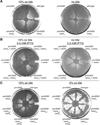Conflicting roles for a cell surface modification in Salmonella
- PMID: 23646936
- PMCID: PMC4081025
- DOI: 10.1111/mmi.12236
Conflicting roles for a cell surface modification in Salmonella
Abstract
Chemical modifications of components of the bacterial cell envelope can enhance resistance to antimicrobial agents. Why then are such modifications produced only under specific conditions? Here, we address this question by examining the role of regulated variations in O-antigen length in the lipopolysaccharide (LPS), a glycolipid that forms most of the outer leaflet of the outer membrane in Gram-negative bacteria. We determined that activation of the PmrA/PmrB two-component system, which is the major regulator of LPS alterations in Salmonella enterica serovar Typhimurium, impaired growth of Salmonella in bile. This growth defect required the PmrA-activated gene wzz(st), which encodes the protein that determines long O-antigen chain length and confers resistance to complement-mediated killing. By contrast, this growth defect did not require the wzz(fepE) gene, which controls production of very long O-antigen, or other PmrA-activated genes that mediate modifications of lipid A or core regions of the LPS. Additionally, we establish that long O-antigen inhibits growth in bile only in the presence of enterobacterial common antigen, an outer-membrane glycolipid that contributes to bile resistance. Our results suggest that Salmonella regulates the proportion of long O-antigen in its LPS to respond to the different conditions it faces during infection.
© 2013 John Wiley & Sons Ltd.
Figures





Similar articles
-
The PmrA/PmrB regulatory system controls the expression of the wzzfepE gene involved in the O-antigen synthesis of Salmonella enterica serovar Typhimurium.Microbiology (Reading). 2011 Sep;157(Pt 9):2515-2521. doi: 10.1099/mic.0.050088-0. Epub 2011 Jun 30. Microbiology (Reading). 2011. PMID: 21719537
-
The PmrAB system-inducing conditions control both lipid A remodeling and O-antigen length distribution, influencing the Salmonella Typhimurium-host interactions.J Biol Chem. 2012 Nov 9;287(46):38778-89. doi: 10.1074/jbc.M112.397414. Epub 2012 Sep 27. J Biol Chem. 2012. PMID: 23019341 Free PMC article.
-
The PmrA/PmrB and RcsC/YojN/RcsB systems control expression of the Salmonella O-antigen chain length determinant.Mol Microbiol. 2006 Apr;60(1):39-50. doi: 10.1111/j.1365-2958.2006.05069.x. Mol Microbiol. 2006. PMID: 16556219
-
The biology of the PmrA/PmrB two-component system: the major regulator of lipopolysaccharide modifications.Annu Rev Microbiol. 2013;67:83-112. doi: 10.1146/annurev-micro-092412-155751. Epub 2013 Jun 17. Annu Rev Microbiol. 2013. PMID: 23799815 Free PMC article. Review.
-
The Salmonella PmrAB regulon: lipopolysaccharide modifications, antimicrobial peptide resistance and more.Trends Microbiol. 2008 Jun;16(6):284-90. doi: 10.1016/j.tim.2008.03.007. Epub 2008 May 6. Trends Microbiol. 2008. PMID: 18467098 Review.
Cited by
-
Evidence for Involvement of the Salmonella enterica Z-Ring Assembly Factors ZapA and ZapB in Resistance to Bile.Front Microbiol. 2021 Feb 25;12:647305. doi: 10.3389/fmicb.2021.647305. eCollection 2021. Front Microbiol. 2021. PMID: 33717045 Free PMC article.
-
LpxT-Dependent Phosphorylation of Lipid A in Escherichia coli Increases Resistance to Deoxycholate and Enhances Gut Colonization.Front Microbiol. 2021 May 4;12:676596. doi: 10.3389/fmicb.2021.676596. eCollection 2021. Front Microbiol. 2021. PMID: 34017319 Free PMC article.
-
Unique Regions of the Polysaccharide Copolymerase Wzz2 from Pseudomonas aeruginosa Are Essential for O-Specific Antigen Chain Length Control.J Bacteriol. 2019 Jul 10;201(15):e00165-19. doi: 10.1128/JB.00165-19. Print 2019 Aug 1. J Bacteriol. 2019. PMID: 31109993 Free PMC article.
-
Opposing Effects of PhoPQ and PmrAB on the Properties of Salmonella enterica serovar Typhimurium: Implications on Resistance to Antimicrobial Peptides.Biochemistry. 2021 Oct 5;60(39):2943-2955. doi: 10.1021/acs.biochem.1c00287. Epub 2021 Sep 22. Biochemistry. 2021. PMID: 34547893 Free PMC article.
-
Lipopolysaccharide O antigen size distribution is determined by a chain extension complex of variable stoichiometry in Escherichia coli O9a.Proc Natl Acad Sci U S A. 2014 Apr 29;111(17):6407-12. doi: 10.1073/pnas.1400814111. Epub 2014 Apr 14. Proc Natl Acad Sci U S A. 2014. PMID: 24733938 Free PMC article.
References
-
- Albers CJ, Huizenga JR, Krom RA, Vonk RJ, Gips CH. Composition of human hepatic bile. Ann Clin Biochem. 1985;22(Pt 2):129–132. - PubMed
-
- Bader MW, Sanowar S, Daley ME, Schneider AR, Cho U, Xu W, Klevit RE, Le Moual H, Miller SI. Recognition of antimicrobial peptides by a bacterial sensor kinase. Cell. 2005;122:461–472. - PubMed
-
- Bastin DA, Stevenson G, Brown PK, Haase A, Reeves PR. Repeat unit polysaccharides of bacteria: a model for polymerization resembling that of ribosomes and fatty acid synthetase, with a novel mechanism for determining chain length. Mol Microbiol. 1993;7:725–734. - PubMed
-
- Breazeale SD, Ribeiro AA, Raetz CR. Origin of lipid A species modified with 4-amino-4-deoxy-L-arabinose in polymyxin-resistant mutants of Escherichia coli An aminotransferase (ArnB) that generates UDP-4-deoxy-L-arabinose. J Biol Chem. 2003;278:24731–24739. - PubMed
Publication types
MeSH terms
Substances
Grants and funding
LinkOut - more resources
Full Text Sources
Other Literature Sources

